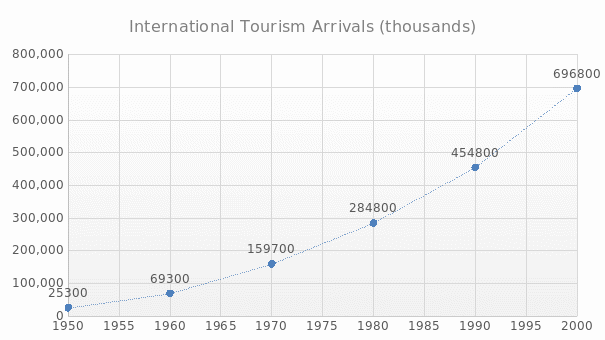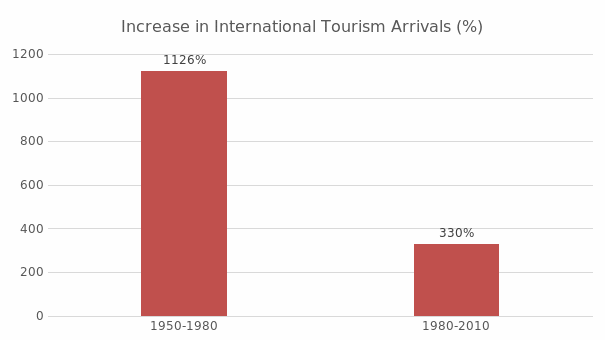Factors Affecting the Demand and Supply for Tourism Industry
International tourism has become a significant industry, affecting the development of many countries. Traditional destinations such as European countries still dominate the market, but new locations are becoming competitive rivals that may soon establish new trends. Various factors have an impact on supply and demand in the area of tourism. It is possible to use PESTLE analysis to consider the central factors.
Political factors that affect the demand and (to a larger extent) supply for international travel include governments’ efforts to further develop an industry (for example, existing infrastructure) that has become profitable for countries’ budgets. Major economic factors having negative effects on demand (as well as supply) include recessions, financial crises (especially international crises), and inflation in countries that are tourist generators.
Growth in GDP, an increase in individual income, and a rise in population (those having a high income) can positively affect demand and supply for tourism. Social factors such as the trend toward an active lifestyle and openness to new experiences contribute to an increase in tourism as the number of tourists grows. Technological factors include the evolution of aircraft, as well as the development of tools and devices that make travel easier (for example, smartphones with maps and descriptions of major destinations and attractions).
Legal factors affecting the supply and demand for tourism are associated with various regulations and laws that favor the development of tourism (for example, tax reduction for hospitality companies). Environmental factors can impose diverse effects as some destinations see a significant increase in visitors while other destinations experience low demand due to unfavorable conditions (extreme temperatures, natural disasters, and so on).
The Growth of Demand in International Tourism
As seen from figure 1, the demand for international tourism has increased significantly since 1950, reaching unprecedented levels. However, the growth was not steady; it was more rapid between 1950 and 1980, compared to the period between 1980 and 2000.

During the earlier period, demand grew by a factor of ten, while during the later period it only tripled (see fig. 2). This difference in growth can be explained by the economic and political situation in the world. The economies of Western countries were booming after the Second World War, allowing more and more tourists to travel between the 1950s and the 1980s. However, the oil crisis of the 1970s led to a significant recession that hit tourist-generating countries.
The Gulf War that started in the 1990s also had a considerable adverse effect on the development of international tourism. Finally, the 9/11 terrorist attack made international (especially air) travel less popular. Although the industry managed to recover fairly quickly, it still did not show the unprecedented growth seen in the period after the Second World War.

It is also important to note that the distribution of tourist arrivals has not been even; European countries have dominated the market since the middle of the 20th century (see fig. 3). However, such events as the Chornobyl incident, terrorist attacks on major US and European cities, and financial crises led to a shift in demand for tourism that made Asian countries more attractive tourist destinations (due to good infrastructure and low prices). At the same time, changes in the number of international tourism arrivals related to particular destinations have happened quickly.

Forecast of Growth in International Tourists
It can be relatively difficult to forecast changes in international tourists as various factors may affect willingness to travel (including natural disasters, wars, terrorist attacks, financial crises, and more). However, the number of international tourist arrivals is likely to grow due to increasing world population as well as the growth of emerging markets. International travel has recovered quite rapidly from various adverse effects and has shown continuous growth.
Thus, after analysis of the growth in international tourist arrivals between 1950 and 2010, it is possible to predict that the number of international tourist arrivals will be around 1,560–1,580 million in 2021 and 2022. Nevertheless, the figures are likely to be very different in the 2030s. It is possible to expect 2.5–3 billion international tourist arrivals worldwide in that later time frame. The forecast is mainly based on the trend apparent in 2000–2010, in which the number of international arrivals almost doubled between 2000 and 2010.
Growth in Receipts from Tourists over Time in 2020, 2021, and 2022
It can be difficult to predict the changes in receipts from tourists as important variables (the financial and political situation in different countries, environmental conditions, and so on) cannot be known ahead of time. However, based on the numbers available, it is possible to forecast growth up to one billion US dollars. National income will increase along with the population of the planet (including those who can afford to travel).
Furthermore, the inflation rate will increase considerably, and the gross percentage of GDP will remain the same. The financial development of countries is one major variable affecting the number of tourists. Therefore, in a relatively unfavorable financial situation in the world, the growth of receipts will not be dramatic, although it will still be substantial as national income will be high. The market will also invariably adjust to new conditions and manage to address major challenges.
“Top Ten” Tourist Generators and the Ten Leading Tourism Destinations
The top ten tourist generators include Canada, the United States, Australia, Japan, China, the United Kingdom, Germany, France, Brazil, and South Korea. The majority of these countries are representatives of the Western world (simultaneously developed countries). Developed countries are major generators as their citizens can afford international travel. The economies of these countries are strong, and people have funds to spend on international flights.
In addition, the list includes several emerging economies, pointing to the existing trend. It is likely that these emerging economies will reach higher positions on the list as their population becomes more well-off and willing to travel. It is also important to add that existing trends in the societies of developed countries as well as emerging markets are associated with the culture of travel, gaining new experiences, becoming open, and so on. Such cultures also are resulting in the growth of the number of tourists.
The leading tourist destinations include France, Spain, Italy, Germany, the USA, the UK, China, Turkey, Malaysia, and Mexico. Interest in visiting European countries is still high for a number of reasons. For instance, these countries have a rich history and high-quality tourist infrastructure. These destinations have also been highly publicized through media. For example, France (Paris) is still regarded as the capital of romance and one of the most romantic places in the world. However, South Asia is becoming an attractive tourist destination because it is exotic (for those from the major tourist generators), the tourist infrastructure is constantly improving, and prices are still low compared to European or US tourist destinations.